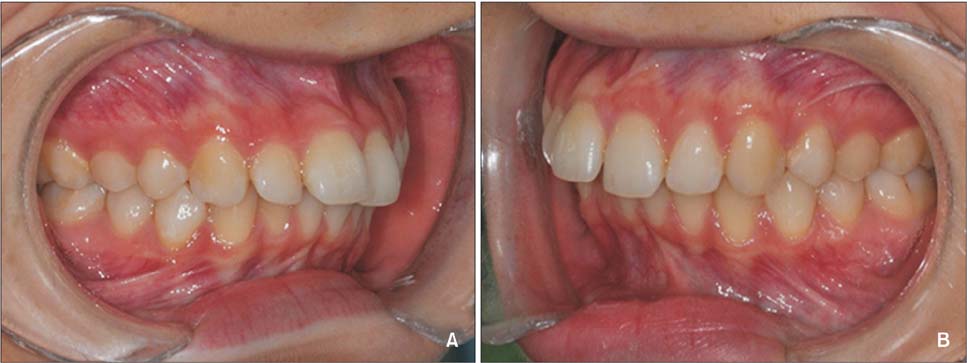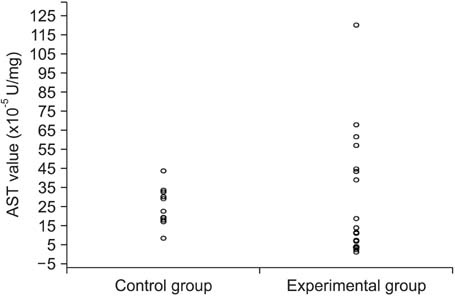Korean J Orthod.
2015 Sep;45(5):261-267. 10.4041/kjod.2015.45.5.261.
Aspartate aminotransferase activity in the pulp of teeth treated for 6 months with fixed orthodontic appliances
- Affiliations
-
- 1Clinic of Dental and Oral Pathology, Faculty of Odontology, Lithuanian University of Health Sciences, Kaunas, Lithuania. veberiene@gmail.com
- 2Kaunas Centre of Orthodontics, Kaunas, Lithuania.
- KMID: 2068521
- DOI: http://doi.org/10.4041/kjod.2015.45.5.261
Abstract
OBJECTIVE
To measure aspartate aminotransferase (AST) activity in the pulp of teeth treated with fixed appliances for 6 months, and compare it with AST activity measured in untreated teeth.
METHODS
The study sample consisted of 16 healthy subjects (mean age 25.7 +/- 4.3 years) who required the extraction of maxillary premolars for orthodontic reasons. Of these, 6 individuals had a total of 11 sound teeth extracted without any orthodontic treatment (the control group), and 10 individuals had a total of 20 sound teeth extracted after 6 months of orthodontic alignment (the experimental group). Dental pulp samples were extracted from all control and experimental teeth, and the AST activity exhibited by these samples was determined spectrophotometrically at 20degrees C.
RESULTS
Mean AST values were 25.29 x 10(-5) U/mg (standard deviation [SD] 9.95) in the control group and 27.54 x 10(-5) U/mg (SD 31.81) in the experimental group. The difference between these means was not statistically significantly (p = 0.778), and the distribution of the AST values was also similar in both groups.
CONCLUSIONS
No statistically significant increase in AST activity in the pulp of mechanically loaded teeth was detected after 6 months of orthodontic alignment, as compared to that of teeth extracted from individuals who had not undergone orthodontic treatment. This suggests that time-related regenerative processes occur in the dental pulp.
MeSH Terms
Figure
Reference
-
1. von Böhl M, Ren Y, Fudalej PS, Kuijpers-Jagtman AM. Pulpal reactions to orthodontic force application in humans: a systematic review. J Endod. 2012; 38:1463–1469.
Article2. Unsterseher RE, Nieberg LG, Weimer AD, Dyer JK. The response of human pulpal tissue after orthodontic force application. Am J Orthod Dentofacial Orthop. 1987; 92:220–224.
Article3. Ramazanzadeh BA, Sahhafian AA, Mohtasham N, Hassanzadeh N, Jahanbin A, Shakeri MT. Histological changes in human dental pulp following application of intrusive and extrusive orthodontic forces. J Oral Sci. 2009; 51:109–115.
Article4. Veberiene R, Smailiene D, Baseviciene N, Toleikis A, Machiulskiene V. Change in dental pulp parameters in response to different modes of orthodontic force application. Angle Orthod. 2010; 80:1018–1022.
Article5. Terespolsky MS, Brin I, Harari D, Steigman S. The effect of functional occlusal forces on orthodontic tooth movement and tissue recovery in rats. Am J Orthod Dentofacial Orthop. 2002; 121:620–628.
Article6. Taşpinar F, Akgül N, Simşek G, Ozdabak N, Gündoğdu C. The histopathological investigation of pulpal tissue following heavy orthopaedic forces produced by rapid maxillary expansion. J Int Med Res. 2003; 31:197–201.
Article7. Hamilton RS, Gutmann JL. Endodontic-orthodontic relationships: a review of integrated treatment planning challenges. Int Endod J. 1999; 32:343–360.
Article8. Grünheid T, Morbach BA, Zentner A. Pulpal cellular reactions to experimental tooth movement in rats. Oral Surg Oral Med Oral Pathol Oral Radiol Endod. 2007; 104:434–441.
Article9. Kayhan F, Küçükkeleş N, Demirel D. A histologic and histomorphometric evaluation of pulpal reactions following rapid palatal expansion. Am J Orthod Dentofacial Orthop. 2000; 117:465–473.
Article10. Konno Y, Daimaruya T, Iikubo M, Kanzaki R, Takahashi I, Sugawara J, et al. Morphologic and hemodynamic analysis of dental pulp in dogs after molar intrusion with the skeletal anchorage system. Am J Orthod Dentofacial Orthop. 2007; 132:199–207.
Article11. Schmidt F, Schmidt W. Aminotransferases in human pathology and clinical chemistry. In : Christen P, Metzler DE, editors. Transaminases. New York: John Wiley & Sons;1985.12. Spoto G, Fioroni M, Rubini C, Tripodi D, Perinetti G, Piattelli A. Aspartate aminotransferase activity in human healthy and inflamed dental pulps. J Endod. 2001; 27:394–395.
Article13. Chambers DA, Imrey PB, Cohen RL, Crawford JM, Alves ME, McSwiggin TA. A longitudinal study of aspartate aminotransferase in human gingival crevicular fluid. J Periodontal Res. 1991; 26:65–74.
Article14. Perinetti G, Varvara G, Festa F, Esposito P. Aspartate aminotransferase activity in pulp of orthodontically treated teeth. Am J Orthod Dentofacial Orthop. 2004; 125:88–92.
Article15. Veberiene R, Smailiene D, Danielyte J, Toleikis A, Dagys A, Machiulskiene V. Effects of intrusive force on selected determinants of pulp vitality. Angle Orthod. 2009; 79:1114–1118.
Article16. Perinetti G, Paolantonio M, D'Attilio M, D'Archivio D, Dolci M, Femminella B, et al. Aspartate aminotransferase activity in gingival crevicular fluid during orthodontic treatment. A controlled short-term longitudinal study. J Periodontol. 2003; 74:145–152.
Article17. Rohaya MAW, Shahrul Hisham ZA, Khazlina K. Preliminary study of aspartate aminotransferase activity in gingival crevicular fluids during orthodontic tooth movement. J Appl Sci. 2009; 9:1393–1396.
Article18. Wei FL, Geng J, Guo J, Guo QY, Wang H, Liu DX, et al. Metabolic changes of human dental pulp after rapid palatal expansion. Orthod Craniofac Res. 2013; 16:185–192.
Article19. Mavreas D, Athanasiou AE. Factors affecting the duration of orthodontic treatment: a systematic review. Eur J Orthod. 2008; 30:386–395.
Article20. Popowich K, Nebbe B, Heo G, Glover KE, Major PW. Predictors for Class II treatment duration. Am J Orthod Dentofacial Orthop. 2005; 127:293–300.
Article21. Shibutani N, Hosomichi J, Ishida Y, Soma K. Influence of occlusal stimuli on the microvasculature in rat dental pulp. Angle Orthod. 2010; 80:316–321.
Article22. Mitchell DL, Boone RM, Ferguson JH. Correlation of tooth movement with variable forces in the cat. Angle Orthod. 1973; 43:154–161.23. Yoshikawa DK. Biomechanical principles of tooth movement. Dent Clin North Am. 1981; 25:19–26.24. Ren Y, Maltha JC, Kuijpers-Jagtman AM. Optimum force magnitude for orthodontic tooth movement: a systematic literature review. Angle Orthod. 2003; 73:86–92.25. Yamaguchi M, Kasai K. Inflammation in periodontal tissues in response to mechanical forces. Arch Immunol Ther Exp (Warsz). 2005; 53:388–398.26. Ramfjord SP, Kohler CA. Periodontal reaction to functional occlusal stress. J Periodontol. 1959; 30:95–112.
Article27. Short E, Johnson RB. Effects of tooth function on adjacent alveolar bone and Sharpey's fibers of the rat periodontium. Anat Rec. 1990; 227:391–396.
Article28. van Leeuwen EJ, Maltha JC, Kuijpers-Jagtman AM. Tooth movement with light continuous and discontinuous forces in beagle dogs. Eur J Oral Sci. 1999; 107:468–474.
Article29. Fortin JM. Translation of premolars in the dog by controlling the moment-to-force ratio on the crown. Am J Orthod. 1971; 59:541–551.
Article
- Full Text Links
- Actions
-
Cited
- CITED
-
- Close
- Share
- Similar articles
-
- A clinical study of the effects of orthodontic appliances on the gingival tissue
- Long-term effects of chlorhexidine varnish treatment on microbial changes of dental plaque in orthodontic patients with fixed appliances
- Considerations for Orthodontic Treatment in Elderly Patients
- Report on a case treated with lingual multibracket appliance
- Diagnosis and Treatment of Malocclusions using the Invisalign System



